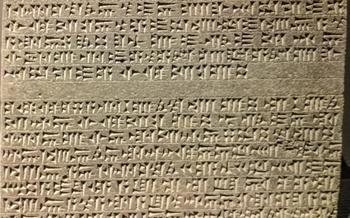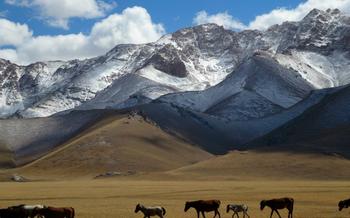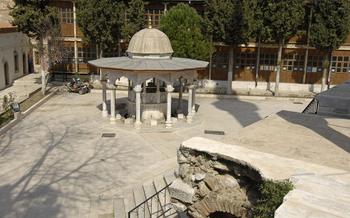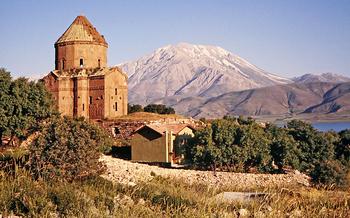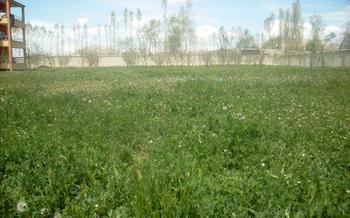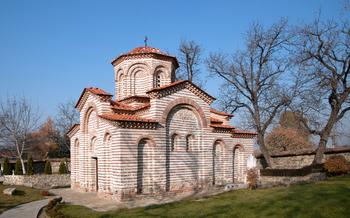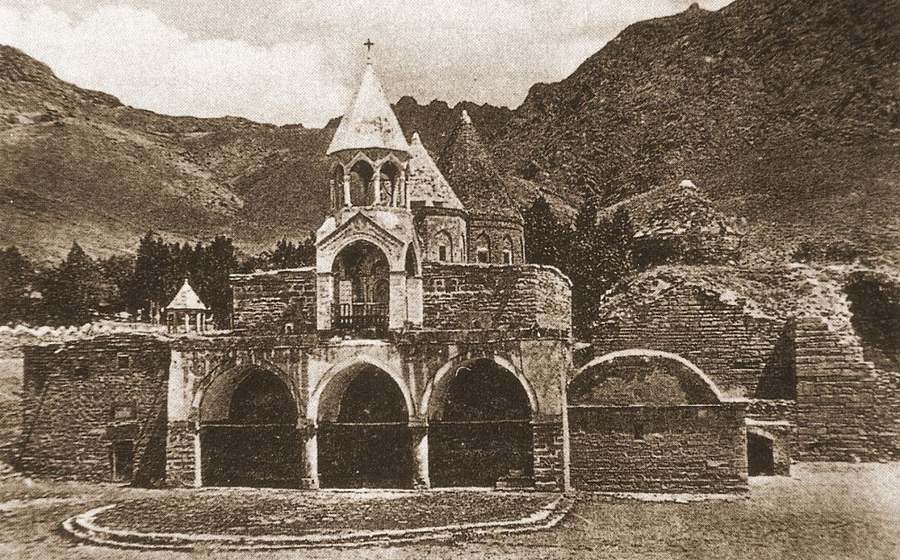
Varagavank Monastery
- Historical Significance
- Location: A Journey to the Shores of Lake Van
- Architectural Marvel
- Monastic Life
- Unique Frescoes
- Cultural Significance
- Restoration Efforts
- Visiting the Monastery
- Nearby Attractions
- Local Cuisine
- Photography Opportunities
- Accommodation Options
- Souvenirs and Handicrafts
- Insider Tip:
Historical Significance
The Varagavank Monastery, nestled in the heart of the Van region in Turkey, holds immense historical significance as a prominent religious and cultural center for the Armenian community. Founded in the 7th century by St. Varag, the monastery grew into a thriving spiritual hub, attracting pilgrims and scholars from across the region. Its strategic location on the shores of Lake Van further enhanced its importance as a center for trade and cultural exchange.
The architectural grandeur of the Varagavank Monastery showcases the exceptional craftsmanship of Armenian builders. The complex comprises several churches, chapels, living quarters, and auxiliary buildings, each adorned with intricate carvings, frescoes, and stonework. The fusion of Armenian and Byzantine architectural styles is evident throughout the monastery, reflecting the region's rich cultural heritage.
Despite enduring various historical trials, including the devastating Armenian Genocide, the Varagavank Monastery has remained a symbol of resilience and perseverance. Its enduring legacy as a center of faith and learning earned it the prestigious designation as a UNESCO World Heritage Site, ensuring its preservation for future generations.
Location: A Journey to the Shores of Lake Van
Situated amidst the breathtaking landscapes of the Van region in eastern Turkey, the Varagavank Monastery stands as a testament to the rich history and cultural heritage of the region. Its location on the shores of the mesmerizing Lake Van, the largest soda lake in the world, adds to its allure. The monastery is easily accessible by various means of transportation, making it a convenient destination for visitors.
Whether opting for public transport, private car, or guided tour, the journey to the Varagavank Monastery promises scenic vistas and a glimpse into the region's diverse natural beauty. The surrounding countryside, dotted with charming villages and rolling hills, offers a picturesque backdrop to the monastery's imposing presence. As visitors approach, they are greeted by breathtaking views of the monastery nestled amidst the tranquil waters of Lake Van, a sight that leaves an unforgettable impression.
Architectural Marvel
The Varagavank Monastery stands as a testament to the exquisite craftsmanship and architectural prowess of the Armenian builders. Its churches, chapels, and living quarters showcase a harmonious blend of Armenian and Byzantine architectural styles, creating a unique and awe-inspiring ensemble.
The main church, Surb Astvatsatsin, boasts an impressive dome supported by four massive pillars, while the smaller churches, Surb Grigor and Surb Hovhannes, display intricate carvings and frescoes that narrate biblical stories and depict scenes from the lives of saints. The monastery's living quarters, once home to the monks, feature vaulted ceilings, arched doorways, and skillfully crafted stonework.
The exterior of the monastery is equally captivating, with its imposing walls adorned with intricate carvings and decorative elements. Visitors can admire the delicate reliefs depicting religious symbols, geometric patterns, and scenes from Armenian history, which add depth and character to the monastery's facade.
The ongoing restoration efforts at the monastery have meticulously preserved its architectural integrity and unique features. Visitors can witness the painstaking work of skilled artisans as they restore the monastery's frescoes, carvings, and stonework, ensuring that this architectural marvel continues to stand as a symbol of Armenian heritage and craftsmanship.
Monastic Life
Within the sacred walls of the Varagavank Monastery, the monks devoted their lives to spiritual pursuits and communal living. Their daily routine revolved around religious observances, prayers, and ascetic practices. They adhered to a strict schedule of worship, attending church services, reciting psalms, and engaging in contemplative meditation. The monks lived a life of simplicity and self-sufficiency, relying on their own labor to sustain their community. They cultivated crops, raised livestock, and practiced various crafts and trades to meet their daily needs. The monastery also served as a center of education, where monks studied religious texts, Armenian history, and the arts. Through their dedication and devotion, the monks of Varagavank played a pivotal role in preserving and transmitting Armenian cultural and religious traditions for centuries.
Unique Frescoes
The interiors of the Varagavank Monastery's churches are adorned with exceptional frescoes that captivate visitors with their vibrant colors, intricate details, and biblical scenes. These artworks, created by skilled Armenian fresco painters, showcase a blend of artistic techniques and deep theological symbolism.
The frescoes depict a vast array of religious themes, from the life of Jesus Christ and the saints to scenes from the Old and New Testaments. The artists employed a unique style characterized by expressive figures, rich colors, and a harmonious composition. The vivid blues, reds, and golds create a sense of awe and grandeur, immersing visitors in the spiritual essence of the monastery.
One of the most striking frescoes is located in the main church, depicting the Last Judgment. The central figure of Christ is portrayed in majesty, surrounded by angels and apostles. The righteous are shown ascending to heaven, while the wicked are cast into hell. The intricate details and symbolism in this fresco convey a powerful message about the consequences of one's actions and the ultimate triumph of good over evil.
Another notable fresco is the depiction of the Transfiguration of Jesus on Mount Tabor. The radiant figure of Christ is surrounded by Moses and Elijah, while the apostles Peter, James, and John witness the miraculous event. The use of light and shadow in this fresco creates a sense of divine presence and heavenly glory.
These exceptional frescoes not only enhance the beauty of the monastery's interior but also serve as a testament to the artistic prowess and deep faith of the Armenian people. They offer visitors a glimpse into the rich theological and cultural significance of the Varagavank Monastery.
Cultural Significance
The Varagavank Monastery played a pivotal role as a cultural and intellectual center for the Armenian community. It served as a repository of centuries-old traditions, language, and literature, fostering a sense of cultural identity and continuity. Within its walls, scholars, scribes, and artists dedicated themselves to preserving and enriching Armenian heritage. The monastery's scriptorium produced illuminated manuscripts and translations of religious and secular texts, contributing to the development of Armenian literature and education. Furthermore, the monastery facilitated interfaith dialogue and cultural exchange, fostering understanding and cooperation between different religious communities throughout history.
Restoration Efforts
The Varagavank Monastery has undergone extensive restoration and conservation projects in recent years, aiming to preserve its architectural integrity and unique features. International organizations, such as UNESCO, and experts in the field of cultural heritage have played a crucial role in supporting these efforts. The restoration process involves meticulous attention to detail, using traditional techniques and materials to ensure the authenticity of the monastery's original design. The challenges faced include the need to address structural damage caused by natural disasters and the passage of time, as well as the careful preservation of the monastery's intricate carvings and frescoes. The ongoing restoration efforts are vital in ensuring that this iconic landmark remains a testament to Armenian heritage and a source of inspiration for future generations.
Visiting the Monastery
Planning a visit to the Varagavank Monastery is a rewarding experience that offers a glimpse into the rich history and cultural heritage of the region. The monastery is open to visitors daily, except for major holidays. Guided tours are available for those who wish to delve deeper into the monastery's significance and architectural details. Visitors can explore the monastery's churches, chapels, and living quarters at their own pace, marveling at the intricate carvings, frescoes, and stonework that adorn the buildings. It's recommended to visit during the morning or late afternoon to avoid the midday heat and capture the best light for photography. Appropriate attire is advised, as the monastery is a sacred site. Visitors should be mindful of local customs and traditions, respecting the sanctity of the monastery and its surroundings.
Nearby Attractions
In the vicinity of the Varagavank Monastery, history buffs can explore the ancient city of Van, just a short drive away. Here, visitors can marvel at the impressive ruins of the Van Castle, which once served as the capital of the ancient Armenian kingdom of Urartu. The castle offers breathtaking panoramic views of the region and a glimpse into its rich past.
Nature enthusiasts can embark on a scenic boat trip on Lake Van, Turkey's largest lake. The lake is renowned for its crystal-clear waters, picturesque islands, and diverse birdlife. Visitors can spot various bird species, including flamingos, pelicans, and cormorants, making it a paradise for birdwatchers.
For those seeking cultural experiences, the city of Van boasts several museums that showcase the region's rich history and culture. The Van Museum, in particular, houses an extensive collection of artifacts from the Urartu civilization, providing insights into their way of life and artistic achievements.
To experience the vibrant local culture, visitors can stroll through the bustling streets of Van, where they can find traditional bazaars, lively markets, and authentic restaurants serving delicious regional cuisine. The city is also home to several mosques, churches, and other religious sites, reflecting its diverse religious heritage.
Local Cuisine
The Van region boasts a distinctive cuisine that reflects its rich history and cultural influences. Visitors to the Varagavank Monastery should not miss the opportunity to sample the local delicacies. Grilled fish from Lake Van is a must-try, as the lake's unique ecosystem imparts a distinct flavor to the fish. Traditional Armenian dishes, such as khashlama (a slow-cooked stew) and dolma (stuffed vine leaves), are also highly recommended. Regional specialties like murtuğa (a type of spicy sausage) and kavut (a sweet paste made from roasted wheat) offer a taste of the region's culinary heritage. For a memorable dining experience, visitors can head to local restaurants or eateries near the monastery or in the city of Van. These establishments often serve authentic dishes prepared using fresh, local ingredients. Visitors should also be on the lookout for unique dining experiences, such as traditional Armenian feasts or cooking classes, that offer a deeper immersion into the region's culinary traditions.
Photography Opportunities
The Varagavank Monastery offers a wealth of photographic opportunities for visitors who wish to capture its beauty and grandeur. The best time for photography is during the golden hours of sunrise and sunset, when the warm light casts a magical glow on the monastery's architecture. The intricate carvings, frescoes, and stonework provide endless subjects for close-up shots, while the panoramic views of the monastery from the surrounding hills are breathtaking. Visitors should also take advantage of the opportunity to photograph the monastery's interior, where the vibrant frescoes and the soft light filtering through the windows create a serene and atmospheric setting. Whether you're a professional photographer or simply enjoy capturing special moments, the Varagavank Monastery is a treasure trove of photographic wonders.
Accommodation Options
When planning your visit to the Varagavank Monastery, consider staying in the nearby town of Van, which offers a range of accommodation options to suit different budgets and preferences. For a comfortable and convenient stay, opt for one of the modern hotels in the city center, such as the Van Oteli or the Sahmaran Otel. These hotels provide amenities like air conditioning, Wi-Fi, and easy access to restaurants and shops.
For a more immersive experience, choose a traditional guesthouse or homestay in the historic Armenian neighborhood of Van. These accommodations offer a unique opportunity to interact with local families and learn about their culture and traditions. Look for guesthouses like the Ani Pansiyon or the Hayk Dun Guesthouse, which provide cozy rooms and warm hospitality.
If you prefer a secluded retreat, consider staying at the Varagavank Monastery Guesthouse, located within the monastery complex. This guesthouse offers basic but comfortable accommodations, allowing you to fully immerse yourself in the monastery's serene atmosphere.
Remember to book your accommodation in advance, especially during the peak tourist season, to secure the best rates and availability.
Souvenirs and Handicrafts
When visiting the Varagavank Monastery, take the opportunity to purchase unique souvenirs and handicrafts that showcase the region's rich cultural heritage. In the vicinity of the monastery, you'll find shops and stalls selling a variety of items, including handwoven carpets, intricate pottery, and traditional Armenian jewelry. These handcrafted treasures make for meaningful mementos of your visit and support local artisans who keep these traditions alive.
One of the must-buy items is a handwoven carpet. The Van region is renowned for its vibrant and intricate carpets, crafted using traditional techniques passed down through generations. These carpets are not only beautiful but also durable, making them a lasting reminder of your time here.
For those who appreciate unique pottery, look out for pieces made using local clay and traditional firing methods. These ceramics often feature intricate designs inspired by Armenian culture and history. From decorative plates to vases and bowls, these handmade items add a touch of rustic charm to any home.
If you're looking for a more personal souvenir, consider purchasing a piece of Armenian jewelry. Artisans in the region craft exquisite necklaces, bracelets, and earrings using silver and semi-precious stones. These unique pieces make for thoughtful gifts or personal keepsakes.
By purchasing souvenirs and handicrafts, you not only take home a piece of the Van region's rich heritage but also support local artisans who are dedicated to preserving these traditional crafts.
Insider Tip:
Uncover the hidden chamber beneath the monastery's main church. This secret chamber, once used for storing precious relics and manuscripts, is now open to visitors. Ask a guide or a monk to show you the entrance, and prepare to be amazed by the beautifully preserved frescoes and artifacts that have survived the centuries. It's a unique opportunity to step back in time and experience the monastery's rich history firsthand.
